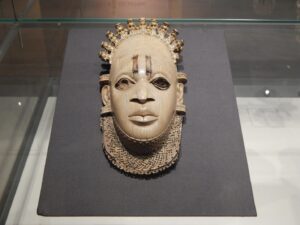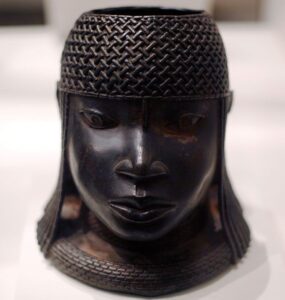By Favour Ibekwe
It is no secret that the giant of Africa is held together thanks to the contributions of its over 300 ethnic groups, languages, and cultural heritages. As globalization continues to influence and reshape societies, preserving the diverse arts and cultures of Nigeria becomes important, now more than ever.

The preservation of Nigerian art, in all its forms, is not just a matter of preserving aesthetic beauty but a vital undertaking to protect cultural identity, environmental resources, and the link between generations. Nigeria’s art holds within it the stories, wisdom, and creativity of its people.
However, as contemporary issues such as deforestation, urbanisation, and inadequate infrastructure threaten the very fabric of this heritage, it is imperative that both the government and private sector take more deliberate steps to protect these cultural treasures as preserving Nigerian art involves more than just preserving its history; it also involves ensuring that upcoming generations are motivated.
It is important to bring to the awareness of the average Nigerian Joe that Nigeria’s arts and cultures are not merely relics of the past but living expressions of identity, history, and community. From the intricate beadwork of the Yoruba to the vibrant masquerades of the Efik, to the indigenous architectural practices of the Fulani, these art forms tell stories that resonate through generations. True enough, Nigeria’s arts and crafts are more than just beautiful objects, they are economic engines. Traditional crafts, performances, and festivals attract tourists from across the globe, eager to experience the richness of Nigerian culture. Artisans and performers, often the custodians of these traditions, rely on these practices for their livelihoods.

Britannica: Benin bronze oba head.
By safeguarding these art forms, Nigeria not only honors its past but also cultivates a thriving cultural economy. The arts, in this sense, are not just a cultural treasure but a golden goose waiting to be nurtured. A culture of preservation is therefore vital for maintaining a sense of identity, fostering community pride, and educating future generations about their roots.
Sure as every cave has it’s monsters, the Nigerian art scene is fraught with challenges as diverse as they are daunting. One may ask: what are the challenges or threats to the framing and preservation of Nigeria’s arts and culture? Look no further.
Climate Change and Environmental Degradation
Rising temperatures, flooding, and pollution are not just environmental issues—they are cultural ones. Ancient artefacts, outdoor sculptures, and historical buildings are particularly vulnerable. The Nok terracottas, for instance, are not just clay figures; they are time capsules of Nigeria’s early civilizations. Yet, they face the risk of being lost to harsh weather and environmental neglect.
Neglect and Lack of Awareness
In the race toward modernization, traditional art forms are often left behind. Funding for cultural preservation is scarce, and public awareness is limited. The result? A generation that knows more about global pop culture than the intricacies of its own heritage. Without intervention, these art forms risk fading into obscurity, taking with them a piece of Nigeria’s soul.
Art Theft and Illegal Trafficking
Nigeria’s artefacts are not just national treasures. They are global commodities. For decades, priceless pieces have been stolen and trafficked to international markets, leaving gaps in the nation’s historical narrative. The Benin Bronzes, for example, are scattered across the world, their absence a stark reminder of the need for stronger protections. There are pieces of stolen Nigeria’s art on display in museums internationally, some carted away during the colonial times, without proper repatriation endeavours in this golden age.
Rapid Urbanization and Cultural Erosion
As cities expand, cultural heritage sites are often sacrificed for modern infrastructure. Traditional art forms, tied to specific communities and landscapes, struggle to survive in the face of urbanization. The challenge lies in finding a balance between progress and preservation, ensuring that Nigeria’s cultural identity is not lost in the concrete jungle.
It is not uncommon to hear questions like “So what’s the government doing about this?” in conversations about Nigeria and Nigerian issues. In this regard, the role of the Nigerian government should be in the implementation of policy as a preservation tool.
The Nigerian government has taken steps to protect its cultural heritage, with institutions like the National Commission for Museums and Monuments leading the charge. However, there is room for improvement. Stronger legislation, stricter enforcement of intellectual property rights, and increased funding for cultural organizations are essential. Policies that incentivize the preservation of traditional art forms while supporting contemporary adaptations could create a harmonious blend of old and new.
What else can be done to build and uphold a cultural legacy?
One of the most powerful tools for preservation is education. Integrating art and cultural studies into school curricula can foster a sense of pride and appreciation for Nigeria’s heritage from an early age. Imagine a generation of young Nigerians who can identify the symbolism in Yoruba carvings or the history behind Igbo uli designs. Beyond schools, public awareness campaigns can reignite interest in traditional art forms, ensuring they remain relevant in a rapidly changing world.
Another really important contribution should be community involvement. Local communities are the lifeblood of Nigeria’s artistic heritage. Grassroots initiatives have already made significant strides in reviving indigenous art forms and practices. From pottery cooperatives to dance troupes, these efforts are keeping traditions alive. Collaborative projects between artists and communities not only preserve cultural practices but also empower local economies.
Last but not the least, social media. In the digital age, social media has emerged as a powerful tool for cultural preservation. Platforms like Instagram, YouTube, and TikTok allow artists to showcase their work to a global audience. Virtual tours of historical sites, live performances of traditional dances, and digital storytelling are bridging the gap between tradition and modernity. These platforms are not just preserving culture, they are reinventing it for a new generation.
Nigeria’s artistic heritage while being a testament to the resilience, creativity and diversity of it’s people, is in danger of fading into obscurity. Yes, its survival depends on collective action. From government policies to community initiatives, from classrooms to social media feeds, every effort counts. By safeguarding its cultural treasures, Nigeria can honour its past, enrich its present, and secure a vibrant future.
A nation’s culture is its heartbeat.
